FlowTestAI
Open siteCoding & Development
Introduction
OpenSource IDE for automated API testing and workflow management.
FlowTestAI Product Information
FlowTestAI IDE/CLI/Analytics is an open-source, GenAI-powered Integrated Development Environment designed to craft, visualize, and manage API-first workflows. It emphasizes speed, light footprint, and local operation to safeguard privacy while enabling seamless API-driven testing and end-to-end workflow automation. It supports multiple LLM providers (OpenAI, AWS Bedrock, and local AI), visual flow-based living documentation, and a drag-and-drop interface for building and managing tests. It aims to bridge APIs and LLMs for enhanced testing, privacy, and collaboration across platforms (OSX, Windows, Linux).
Key Capabilities
- End-to-end API testing workflow authoring in a visual, flow-based format
- Natural language to executable API workflows via FlowTestAI’s “Enter Prompt” to “Create Flow” and “Run Flow” capabilities
- Living documentation: visual flows serve as up-to-date behavioral documentation for API usage
- Contextual and user-centric testing to mirror real-world interactions
- Local-first design: data stays on your machine, credentials are handled securely
- Open source: community-driven development and extensibility
- Multi-LLM support: choose from OpenAI, AWS Bedrock, and locally hosted models
- Integration-ready: CLI, local SDK, and APIs to fit into CI/CD pipelines
- Visualization: clear, graphical traces of API calls for easy debugging and onboarding
- FlowTestAI Analytics: identify slow tests, pinpoint failures, and monitor overall health
- Drag-and-drop interface for creating and managing API tests without writing extensive scripts
- Binding APIs and seamless harmony between APIs and LLMs for comprehensive testing
How It Works
- Describe desired end-to-end API behavior in natural language (Describe your desired end-to-end customer experience).
- FlowTestAI translates it into an executable end-to-end API workflow.
- Use the visual Flow Editor to refine, run, and iterate tests.
- View analytics dashboards to improve test reliability and performance.
Product Offerings
- FlowTestAI IDE: Powerful, cross-platform IDE for creating, managing, and collaborating on end-to-end API tests with a visual interface.
- FlowTestAI CLI: Command-line tooling to create, run, publish, and integrate flows into CI/CD.
- FlowTestAI Analytics: Data-rich dashboards for test health, performance, and failure pinpointing.
Safety and Privacy Considerations
- Local-first operation minimizes exposure of credentials and private endpoints.
- Data never needs to leave your development environment for core testing tasks.
How to Use FlowTestAI
- Install FlowTestAI IDE (or use CLI for scripting).
- Create a new API test flow using the visual Flow Editor or describe a flow in natural language.
- Bind to APIs and configure endpoints, credentials, and models (OpenAI, AWS Bedrock, or Local models).
- Run the Flow to execute API tests end-to-end.
- Inspect the visual trace and analytics to improve reliability and performance.
Supported Platforms
- FlowTestAI IDE: macOS, Windows, Linux
- CLI and Analytics components available for integration into existing toolchains
Security & Compliance
- Local data processing with secure credential handling and private endpoints.
- Open-source license enables transparency and auditability.
Core Features
- Local-first, privacy-conscious operation with credentials handled securely
- Open-source IDE, CLI, and analytics for API testing
- End-to-end API workflow authoring from natural language to executable flows
- Visual, drag-and-drop flow editor for API tests
- Living documentation via visual flows illustrating API usage
- Multiple LLM backends: OpenAI, AWS Bedrock, and Local AI integration
- CI/CD integration through FlowTestAI CLI and automation capabilities
- Flow-based analytics: overall health, performance, and pinpoint failure insights
- Seamless binding of APIs and LLMs to create integrated test scenarios
- Cross-platform support (OSX, Windows, Linux)
